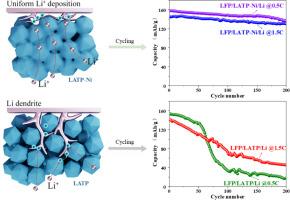原子焊接提高了 Li1.3Al0.3Ti1.7(PO4)3 (LATP) 固体电解质的机电性能
IF 18.9
1区 材料科学
Q1 CHEMISTRY, PHYSICAL
引用次数: 0
摘要
目前,固态电解质(SSE)的实际应用受到固态电池(SSB)循环过程中锂金属枝晶不断生长和侵蚀的阻碍,这主要是由于固态电解质薄膜存在大量晶界和断裂韧性较低所致。为了解决这个问题,我们提出了一种以掺杂镍为桥梁的原子焊接策略,以提高 Li1.3Al0.3Ti1.7(PO4)3 (LATP) SSE 的离子导电性、密度和断裂韧性。该 SSE 的断裂韧性可从 1.01±0.2 MPa-m1/2 提高到 1.88±0.2 MPa-m1/2,这对于抑制锂枝晶的渗透以及在长时间循环过程中保持 LATP 与锂金属之间稳定的界面是必要的。因此,Li/LATP-Ni/Li 对称电池在 0.1 mA/cm2 下成功地进行了 400 小时的电静电循环,而 LFP-Li 全电池在 1.5 C 下循环 200 次后,容量保持率高达 90.8%。这些发现不仅提供了一种原子焊接的 SSE 薄膜致密化方法,还为与锂金属阳极竞争实现高能 SSB 提供了启示。本文章由计算机程序翻译,如有差异,请以英文原文为准。

Atomic Welding Enhancing the Electromechanical Performance of Li1.3Al0.3Ti1.7(PO4)3 (LATP) Solid Electrolyte
Practical application of solid-state electrolyte (SSE) is currently impeded by the ongoing growth and erosion from Li metal dendrites during cycling in solid-state batteries (SSBs) mainly due to the presence of abundant grain boundaries and low fracture toughness of SSE film. To address this issue, an atomic welding strategy bridged by Ni doping is proposed to enhance the ionic conductivity, the density, and fracture toughness of Li1.3Al0.3Ti1.7(PO4)3 (LATP) SSE. The fracture toughness of the SSE can be improved from 1.01±0.2 MPa·m1/2 to 1.88±0.2 MPa·m1/2, which is proved necessary to inhibit the penetration of Li dendrite and maintain stable interface between LATP and Li metal during long cycling. As a result, the Li/LATP-Ni/Li symmetric cell succeeds in the galvanostatic cycling for 400 h at 0.1 mA/cm2 while a high capacity retention of 90.8% is achieved with the LFP-Li full cell cycled at 1.5 C after 200 cycles. These findings not only provide an atomic-welding method for densifying SSE films, but also enlighten to competing with Li metal anode for achieving high-energy SSBs.
求助全文
通过发布文献求助,成功后即可免费获取论文全文。
去求助
来源期刊

Energy Storage Materials
Materials Science-General Materials Science
CiteScore
33.00
自引率
5.90%
发文量
652
审稿时长
27 days
期刊介绍:
Energy Storage Materials is a global interdisciplinary journal dedicated to sharing scientific and technological advancements in materials and devices for advanced energy storage and related energy conversion, such as in metal-O2 batteries. The journal features comprehensive research articles, including full papers and short communications, as well as authoritative feature articles and reviews by leading experts in the field.
Energy Storage Materials covers a wide range of topics, including the synthesis, fabrication, structure, properties, performance, and technological applications of energy storage materials. Additionally, the journal explores strategies, policies, and developments in the field of energy storage materials and devices for sustainable energy.
Published papers are selected based on their scientific and technological significance, their ability to provide valuable new knowledge, and their relevance to the international research community.
 求助内容:
求助内容: 应助结果提醒方式:
应助结果提醒方式:


